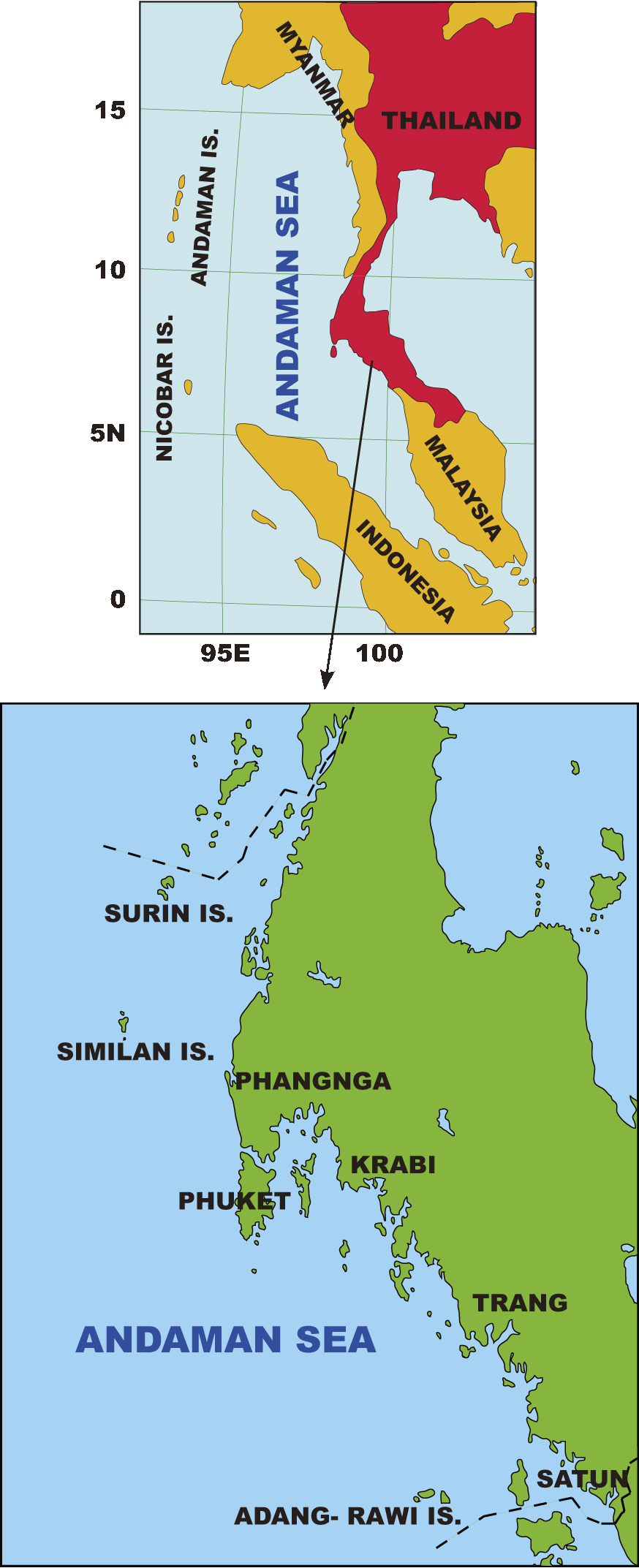|
|
Introduction Pendahuluan
by Seishi Kimura and Ukkrit Satapoomin
|
|
The Andaman Sea, faced by western coast of peninsular
Thailand, is located in the east end of Indian Ocean, surrounded
by northwards Gulf of Martaban, Myanmar, eastwards Malay Peninsula,
southwards northern tip of Sumatra, and westwards Andaman and Nicobar Islands,
with area of 797,700 km2 and maximum depth of 3,777 m. Although
it biogeographically belongs to the eastern Indian Ocean,
it is strongly influenced by the western Pacific Ocean, because
of its connection with the latter through the Straights of Malacca.
The Andaman Sea, encircled by islands and land areas as stated above,
has been a distinctly closed and isolated basin during the Pleistocene,
the last glacial period (about 12,000 years ago), when the sea level was estimated
as being 100 m lower than at present (Morley and Flenley, 1987).
Several fish species were considered that they speciated in the closed basin
in the Pleistocene and became endemic species to the Andaman Sea at present
(Randall and Satapoomin, 1999; Motomura and Senou, 2002).
Thus the Andaman Sea coast of southern Thailand shows much abundant coastal fish fauna,
because of its situation at the junction of the two Oceans, having much variable habitats
as coral reefs, sandy beaches, mad flats, and mangroves, and several endemic species.
However, it is not easy to identify these fishes because of absence of adequate books.
Therefore we started field research of fishes in the area from 2002 to make a filed guide
for fishes of Andaman Sea coast of southern Thailand.
This book is compiled based on the above field research,
museum collections, and underwater photographs of fishes taken from the area.
We intend this book to be useful for study and research of ichthyology
and fishery science by researches, students and local government administrators.
This book is published on the basis of our previous book, Fishes of Libong Island,
west coast of southern Thailand (Matsuura and Kimura, 2005),
expanding target area to the whole Andaman Sea coast southern Thailand,
with the similar aims as our earlier publications,
Field Guide to Lombok Island (Matsuura et al, 2000) and Fishes of Bitung (Kimura and Matsuura, 2003).
This project was supported by the National Muesum of Nature and Science,
Tokyo (NSMT) the Japan Society for the Promotion of Science (JSPS),
under the JSPS Core University Program, and the Phuket Marine Biological Center (PMBC).
The preparation of this book was partially supported by grants
from the JSPS-Multilateral Cooperative Research Program "Coastal Oceanography"
and the Ministry of Environment, Government of Japan (MOE)-Global Environment Research Fund.
(Seishi Kimura)
Collection Sites

The Andaman Sea is a body of water to the southeast of Bay of Bengal,
with a rough dimension of 1,200 km long and 650 km wide.
It is a marginal sea separated from the main Indian Ocean by the Andaman and Nicobar island arcs.
At its southeastern reaches, the Andaman Sea narrows to form the Straights of Malacca,
which separate the Malay Peninsula from the island of Sumatra.
Along an approximate 1,014 km length of the Andaman Sea coast of Thailand,
various types of marine and coastal habitats are developed. Mangroves,
mud flats, and seagrass beds dominate the wave-protected bays and shorelines.
These habitats are typical among coastal provinces in the southern part of the Thai-Malay peninsula,
particularly those bordering the Phangnga Bay and southward to Trang and Satun provinces.
Corals reefs, rocky reefs and/or underwater pinnacles can be found in more wave-exposed areas.
In particular for coral reefs, these habitats are well developed on coastlines or islands far away
from the influences of river discharge, turbidity, and siltation.
All of the above marine and coastal habitats are vital and support a vast variety of marine biota,
including fishes.
As no extensive guide book to fishes of the Andaman Sea coast of Thailand
ever made available before,
this is a first accomplishment of comprehensive field guide to fishes of the area.
The book highlights fishes associated with major coastal marine habitats spanning
from mangrove creeks and seagrass beds to coral reefs.
Collections of fishes inhabit shallow areas of mangroves and seagrass beds were carried
out at several localities in Phangnga, Phuket, and Trang provinces.
Fishes were collected mainly by using beach seine, beam trawl, and handed push-net.
Hand net and ichthyocides (quinaldine and tea-seed powder extracts) were also used
to collect fishes stay in tide-pools on the exposed seagrass beds and small bottom-dwelling fishes stay
in small tributaries in mangrove forests. Surveys of coral reef fishes were made
at almost all major coral reef areas including offshore islands of Surin, Similan,
and Adang-Rawi island groups as well as coastal reefs and near-shore islands in Phangnga,
Phuket, Krabi, and Trang provinces. Inventory species list was obtained by underwater observations.
Underwater photographs were taken, where possible, for verification of species identification.
Hand spear was used for collecting fishes on coral reefs as well as in the forereef areas
of sandy to muddy-sand bottoms. At some selected sites in Phuket,
ichthyocides were used to collect fishes on intertidal reef flats, sand flats,
and rock pools, particularly at low tides.
In late 1993, Dr. Richard Winterbottom of the Royal Ontario Museum,
and parties had conducted an extensive sampling program of coral reef fishes in Phuket areas.
Their rotenone samplings yielded a large numbers of voucher specimens
and many photographs of freshly collected specimens have been authorized for illustrations in this book.
In addition, fishes in commercial catches, obviously by trawlers,
at the fish-landing place or those of artisanal fisheries (mainly by traps, hand lines, and gillnets)
sold at local fish markets in Phuket were surveyed and collected on many occasions. (Ukkrit Satapoomin)
|
|
|